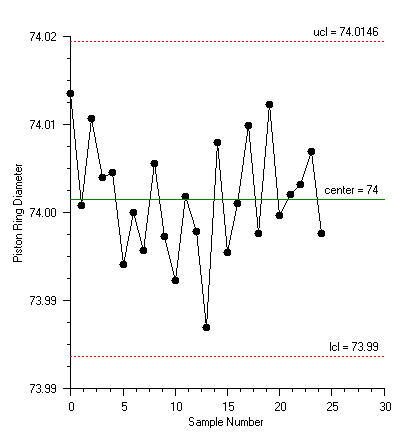XbarR and RChart
If the sample sizes are small, say less than 10, then the in-sample ranges can be used instead of the in-sample standard deviations. The XbarR class plots the mean of each sample as well as control limits computed using the mean of the in-sample ranges. The positions of the control limits are determined by the equations


where  is the grand mean (the
average of all obeservations), and
is the grand mean (the
average of all obeservations), and  is the mean of the distribution of the ranges
of n samples from the normal distribution with mean of zero and standard
deviation of one. The standard deviation of this distribution is
is the mean of the distribution of the ranges
of n samples from the normal distribution with mean of zero and standard
deviation of one. The standard deviation of this distribution is  . Therefore
. Therefore

is an estimator of the standard deviation of the ranges.
XbarR Example
This example creates an XbarR chart using the same piston ring data previously used for the XbarS example. Here the in-sample ranges are used to compute the control limits, rather than the in-sample standard deviations (Montgomery 215).

using Imsl.Chart2D;
using Imsl.Chart2D.QC;
public class SampleXbarR : FrameChart {
static double[][] diameter = {
new double[] {74.03, 74.002, 74.019, 73.992, 74.008},
new double[] {73.995, 73.992, 74.001, 74.011, 74.004},
new double[] {73.988, 74.024, 74.021, 74.005, 74.002},
new double[] {74.002, 73.996, 73.993, 74.015, 74.009},
new double[] {73.992, 74.007, 74.015, 73.989, 74.014},
new double[] {74.009, 73.994, 73.997, 73.985, 73.993},
new double[] {73.995, 74.006, 73.994, 74, 74.005},
new double[] {73.985, 74.003, 73.993, 74.015, 73.988},
new double[] {74.008, 73.995, 74.009, 74.005, 74.004},
new double[] {73.998, 74, 73.99, 74.007, 73.995},
new double[] {73.994, 73.998, 73.994, 73.995, 73.99},
new double[] {74.004, 74, 74.007, 74, 73.996},
new double[] {73.983, 74.002, 73.998, 73.997, 74.012},
new double[] {74.006, 73.967, 73.994, 74, 73.984},
new double[] {74.012, 74.014, 73.998, 73.999, 74.007},
new double[] {74, 73.984, 74.005, 73.998, 73.996},
new double[] {73.994, 74.012, 73.986, 74.005, 74.007},
new double[] {74.006, 74.01, 74.018, 74.003, 74},
new double[] {73.984, 74.002, 74.003, 74.005, 73.997},
new double[] {74, 74.01, 74.013, 74.02, 74.003},
new double[] {73.982, 74.001, 74.015, 74.005, 73.996},
new double[] {74.004, 73.999, 73.99, 74.006, 74.009},
new double[] {74.01, 73.989, 73.99, 74.009, 74.014},
new double[] {74.015, 74.008, 73.993, 74, 74.01},
new double[] {73.982, 73.984, 73.995, 74.017, 74.013}
};
public SampleXbarR() {
Chart chart = this.Chart;
AxisXY axis = new AxisXY(chart);
XbarR xbarr = new XbarR(axis, diameter);
xbarr.UpperControlLimit.SetTitle("ucl = {0:0.0000}");
axis.AxisX.AxisTitle.SetTitle("Sample Number");
axis.AxisX.AxisLabel.TextFormat = "0";
axis.AxisY.AxisTitle.SetTitle("Piston Ring Diameter");
axis.AxisY.AutoscaleInput = Axis.AUTOSCALE_OFF;
axis.AxisY.SetWindow(73.985, 74.015);
}
public static void Main(string[] argv) {
System.Windows.Forms.Application.Run(new SampleXbarR());
}
}
|
PHONE: 713.784.3131 FAX:713.781.9260 |
